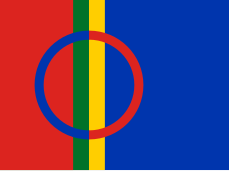Sami flag
 |
|
| Use | Civil flag and ensign |
|---|---|
| Adopted | 15 August 1986 |
The Sami flag is the flag of the Sámi people, the indigenous nation of the Nordic countries and the Kola Peninsula of the Russian Federation. The flag is also sometimes used to represent the territory of Sápmi, the traditional area of Sámi inhabitance.
The first, unofficial Sámi flag was designed by Coast Sámi artist Synnøve Persen from Porsáŋgu in 1977. It was used as a national symbol in the demonstrations against the planned Alta Dam; an event which triggered a new era in Sámi politics and has attained strong symbolic significance. The flag was a tricolor structured in a way suggesting the Nordic cross applied on the flags of the Nordic countries. The colours (blue, red and yellow) are commonly used on gáktis - the traditional Sámi garb.
The first official Sámi flag was recognized and inaugurated on 15 August 1986 by the 13th Nordic Sami Conference in Åre, Sweden. The flag was the result of a competition for which more than seventy suggestions were entered. In the end, one new design was considered against the existing, unofficial flag - and came out winning. The design was submitted by the Coast Sámi artist Astrid Båhl from Ivgubahta/Skibotn, in Tromssa/Troms county, Norway.
The basic structure of Persen's flag was retained, but Båhl added the colour green - which is popular on many South Sámi gáktis. These four colours have been known since then as "the Sámi (national) colours". She also added a motif which derived from a sun/moon symbol appearing on many shaman's drums. While drawings on shaman's drums were only made in red (using an extract of the sacred alder tree), the motif on the flag uses both blue and red - the first representing the moon, the latter representing the sun. Pantone colour formula is: red 485C, green 356C, yellow 116C and blue 286C.
...
Wikipedia
